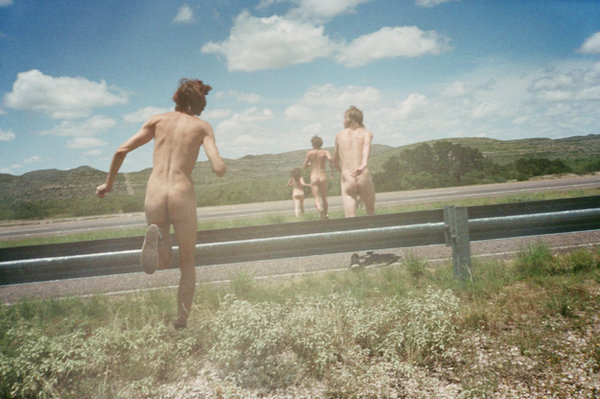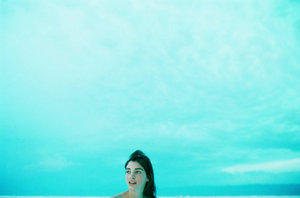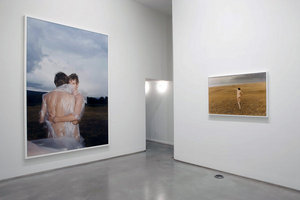This is an archive of the ArtCat Zine, 2007-2009. Please visit our new project, IDIOM.
Ryan McGinley at Team

Ryan McGinley
I Know Where the Summer Goes
Ryan McGinley
3 April - 3 May 2008
Team Gallery - 83 Grand Street, New York NY
New York based photographer Ryan McGinley made a surprising admission in the press release for his latest show, I Know Where the Summer Goes: his photographs are staged. In fact, the lithe young things writhing in the 30 or so pictures on display at Team Gallery are models that he cast in an official casting call where each potential model was judged on "mellowness... strong personalities," comfort naked and "long-limbed[ness]." And then the road-trip across the country was meticulously planned, with locations extensively researched for their symbolic weight and McGinley planning plenty of activities for his hired cadre of enthusiastic companions to partake in. The truth is that McGinley’s images have always been staged in his drive to create an aesthetic world where youth runs wild against the backdrop of iconic landscapes of the American West, this is just the first time he admitted it on paper.
This explicit admission forces the photographs to stand on their own, without playing on the audience’s fantasies about the spontaneity of their creation. In previous bodies of work, McGinley’s photographs have largely ridden on their off-the-cuff sex appeal: the images have captivated viewers with their patina of sex, drugs and rock n’ roll, without any of the harsh, gritty, uncomfortable realism of documentary photographers Larry Clark or Nan Goldin. In the former photographic world of Ryan McGinley, youthful exuberance trumped all as adolescents playfully wrestled, jumped, frolicked, fed horses, and unselfconsciously fucked in shower stalls.
As a person in my twenties, tangentially part of the community McGinley purports to represent, I have long resented him for promoting a patently false, fetishistic image of an East Village hipster milieu whose reckless abandon is largely inspired by self-destructive drug use. At best, this falsehood was a tired old cliché that has sold art for decades. At worst, it was part of a collective fantasy of immortality that can — and has — had disastrous consequences.
I would like to believe that certain personal tragedies contributed to this apparent maturation and shift in tone, although I realize that I Know Where the Summer Goes may simply be the natural progression of a diligent artist winnowing down his aesthetic interests. Either way, the series showcases a marked departure from McGinley’s earlier work, even though the component parts have remained the same: he is still asking his subjects to drive naked with him on a summer road-trip.
The photographs on display have a subtle air of sadness and vulnerability not seen before. The opening photograph, Coley (Injured), shows a wet and cold Coley, with a bandage barely covering a large gash on his upper thigh. In Ann (Sand) Ann shields herself from a ray of sunlight that has already burnt her skin bright red, and in successive falling pictures (Fading Falling, Falling Green Water, Ann (Slingshot), Falling (Sand), and Diving Water), the subjects are rendered impotent against the forces of gravity. More often than not the weather conditions are dark, foreboding or bleak: in Ann (Windy Truck) Ann grimaces as she sits facing a strong headwind, and in Laura (Thunderstorm) Laura looks towards a companion as dark clouds gather above. The only image of two people touching, Brennan (Clear Poncho), has two boys tenderly holding on another in a protective, brotherly embrace.
Though his unabashed use of smoke machines and fireworks infuse the show with an air of good-humored camp, McGinley over-relies on tricks such as depicting subjects constantly in motion (running, falling) as well as making use of extensive dodging and burning techniques in printing. One photograph of a slim girl running or a young man falling has a stronger impact than the cumulative effect of the dozen included in the show. And the image Sliding Sunset Spotlight is so obviously doctored that it sheds doubt on the veracity of the printing of the other works. Nonetheless, the series showcases McGinley’s ability to abstract the human body and create beautiful images — this show proves that he does not need our fantasies about drunken hedonism to bolster his work.
The nude in the American landscape and the exploits of youth are not groundbreaking subjects in photography — Edward Weston, Larry Clark, and hundreds of other photographers have been exploring these same ideas since the medium's invention — but McGinley’s graphic works are a compelling and artistically respectable exploration of unadorned youthful vulnerability set against the monumental American West and they add a fresh contemporary voice to that ongoing photographic conversation. The show is on display at Team Gallery in SoHo until 3 May, 2008.
ZINE
HOME
TIPS / COMMENTS
CATEGORIES
CONTRIBUTORS
- Greg Afinogenov
- B. Blagojevic
- Adda Birnir
- Susannah Edelbaum
- Julie Fishkin
- Paddy Johnson
- Jessica Loudis
- Christopher Reiger
- Andrew Robinson
- Peter J. Russo
- Blythe Sheldon
- S.C.Squibb
- Hrag Vartanian


